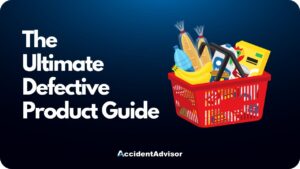If you or a loved one was injured by a defective product, you may be wondering how to get compensation for your medical expenses. The main things you should do is get medical help, assemble the evidence needed for your case, and contact a product liability attorney experienced in similar cases to help you file a successful claim.
While that seems cut-and-dry, all products and companies are different. Whether your purchase is viable for a refund or whether you can claim your injuries in a defective product lawsuit depends on the company’s policies, the legal status of any relevant product recalls, and your ability to meet your state’s filing deadlines.
Since this process can be complicated, we laid out the main steps for you to follow if you were injured by a defective product. Just keep in mind that only an experienced lawyer can advise you on your specific case.
Get Medical Help Immediately
Product injuries can be acute or chronic, but you should get medical help immediately either way. In the case of an acute injury, go to the hospital or call 911 as soon as the injury occurs. In the case of a chronic injury, you need to see a doctor as soon as you discover the injury.
In either example, waiting to report an injury can hurt your case. Accredited doctors must document your injuries and give their opinion on whether you were injured by the product. This is even more complicated in cases involving chronic injuries since prior conditions and other possibilities cast doubt on whether the product caused or contributed to the injury in your claim.
For example, if a safety harness snaps on your child’s car seat and they are injured, you should take them to the emergency room to have their injuries officially evaluated. Explain to the doctor what happened so that the full circumstance of the incident makes it into their report. In another example, a toy that contains lead paint may hurt your child over time. But you should still take them to the emergency room so that their injuries can be evaluated as soon as you become aware of them.
Delaying this process of notification and documentation will hurt your case because the product manufacturer can claim that either the injury was not that severe or the product must not have caused it.
Preserve the Product and Proof of Purchase
You need to prove that you bought the defective product in question when presenting your case for compensation, meaning you should keep both the product and proof of purchase. This could include a receipt, email confirmation, an account summary from a store’s website, or a bank statement.
Note that not all cases will require proof of purchase, especially if the product is a known liability and you still have the product itself. However, in nearly all cases, keeping the product is a pre-requisite to being compensated for your injuries since the court will need to confirm that the product you bought is the model or batch that has been deemed defective. They will also have to evaluate whether the defect was caused by the manufacturing or design of the product, rather than by your negligent use of it.
Remember that the company, its insurers, and its legal representatives are all against you in a case involving defective product injuries. Your legal team has the responsibility to prove that you owned the product, though not all cases require that you prove the product was defective, especially if the FDA, CPSC, or other relevant commission has already initiated a product recall.
Document Everything
To prove that you were injured by a defective product, you need to document everything, which includes taking photos of your injuries and the product itself. Then, you need to assemble your medical records and history, especially if the injury is chronic. This is because the manufacturer’s legal team may claim that your prior medical history contributed to or caused your injury rather than the product. For instance, in the case of developing cancer after using a weed killer, you would have to demonstrate that you did not have a prior risk of cancer in your medical records.
You should also collect the statements and contact information of any relevant witnesses, such as passersby on the street who saw your stroller break or other passengers in the car when a safety seat failed. You should also keep any evidence, such as burned or bloody clothes, pieces of the broken product, and anything else related to the injury.
The manufacturer’s insurers may contact you with questions about your medical history. Note that you are not obligated to disclose information to them out of court and should wait to speak with your attorney before revealing your private records. Remember that their goal is to deny you compensation based on your history.
Do NOT Post on Social Media
While it may be tempting to make a humorous or even serious post about your injury online, you should refrain from doing so as this can jeopardize your defective product injury claim. The opposing legal team may claim that your post, especially if it’s humorous, implies that your injury was not that serious.
Your post may also endanger your case by creating a contradiction between the timeline of events in your claim and the evidence you post online. To be safe, you should always refrain from posting anything about the product injury on Facebook, Twitter, Instagram, or anywhere else. Speak with your attorney about what you could post and when it would be okay to do so.
Contact a Defective Product Attorney
The best thing you can do if you were injured by a product is to contact an experienced defective product attorney. However, you may not know how to find the right lawyer for your case, so go through this brief guide on how to find an attorney near you who will represent your case successfully.
- Research your local Bar Association – Your state will have a registry that shows the accredited law firms in your area that can handle your case. This is a great way to narrow the field without relying on TV ads.
- Ask friends and family – You may know someone who has used an injury attorney in your area. Ask someone you trust about their experience to evaluate whether they could help you as well.
- Evaluate their experience with past cases – Either through research or through asking them during a free consultation, figure out whether a prospective law firm has experience in cases dealing with defective products, as well as whether they were successful.
- Ask how you will pay them – Many law firms only get paid if they win your case. You should make sure that your choice operates this way since the last thing you want is to pay expensive legal fees for a case you didn’t win.
All law firms are different, so make sure you write down the questions you want to ask before getting a consultation. Once you hire them, make sure you do what they say to ensure your case goes your way.
File a Defective Product Lawsuit
To file a defective product lawsuit, you must obey the deadlines of your state, the rules of filing defective product lawsuits, and the advice of your lawyer. First, you have to make sure you file on time, meaning you need to know the statute of limitations in your state. This is the time you have after being injured or discovering a chronic injury to file your case.
You then must identify the defendant relevant to your case. This can change depending on whether the defect that caused your injury was an issue with design, manufacturing, or marketing.
- For design defects, the product itself was faulty, which injured you or failed though you used it properly. Design defects include weak straps in safety harnesses, clothes whose materials are fire hazards, toys that are choking hazards, and more. Design defects often result in a full product recall.
- For manufacturing defects, the product may have been designed properly but was manufactured poorly. This could include chemical contaminants or physical defects that happened during the manufacturing process. Manufacturing can result in a full recall but could also warrant a partial recall of certain batches of a product.
- Finally, marketing defects result from a failure to warn consumers about a product’s dangers, such as a choking hazard or a chemical additive. Depending on the defect your case addresses, the defendant in your case may be the manufacturer, designer, or marketer, including the company, the retailers, the factory that made it, and more.
After choosing a defendant and formally filing your claim in civil court, the hearing will begin with pleadings. Next comes the discovery phase. This is the process of revealing and reviewing the evidence, hearing both side’s intended arguments, and learning the facts and witness reports that support them.
If the lawsuit proceeds to a trial, the judge will hear the arguments and the evidence, including rebuttals, and will then issue a verdict. If you are not satisfied with the results, you may file an appeal to try and overturn the ruling or initiate a retrial due to an error or new evidence. However, you should speak with your lawyer about whether it is financially sensible for you to do so.
Receive a Defective Product Settlement
To receive a defective product settlement, you need to calculate your claim accurately, starting with the medical expenses, lost wages, and other monetary costs related to your injury. You can then include pain and suffering and emotional trauma as a multiplier, something your lawyer will help you calculate accurately.
Defective product injuries settlements cannot be accurately averaged since they can be as little as nothing and as large as hundreds of millions of dollars in damages. Consider the Johnson v. Monsanto Co. case, concerning a man named Dewayne Johnson who contracted non-Hodgkin’s lymphoma after using Roundup weedkiller and was awarded $289 million in damages.
Only an attorney experienced in product liability cases can review your situation and inform you how much you can expect to get from your case if you win.
Conclusion
Defective product injuries can be difficult to settle since they can involve acute or chronic injuries, multiple defendants, and multi-trial litigation. To win your case, you must assemble the right evidence, file by the deadline, refrain from posting on social media, and find the right attorney. They’re the only ones that can advise you on the particulars of your case to help you estimate your settlement and win the compensation you deserve for your injuries.

Rocky Horton
Author
Rocky Horton is a health and safety expert from Chapel Hill, NC. He is the founder of AccidentAdvisor and has been featured in Forbes, Bloomberg, and other publications. Learn more.













